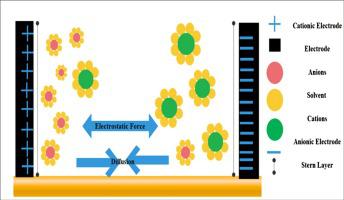Journal of Environmental Chemical Engineering ( IF 7.4 ) Pub Date : 2020-08-30 , DOI: 10.1016/j.jece.2020.104413 Karishma Maheshwari , Madhu Agrawal

|
Traditionally, Reverse osmosis (RO) has gained worldwide acceptance due to its potentially high efficacy towards the attenuation of a wider range of contaminants from salt ions to microbial level pollutants but the technology yet needs to be focused for the indigenization of huge concentrate emerging as reject stream (RS) from the process. This review presents the recent technologies implemented and futuristic approaches proposed for the treatment of RS. This paper comprises the chemical composition of reject stream primarily including total dissolved salts (TDS) of the real samples of RS from few investigations reported. Also, the treatment approaches available for reject have been summarized with their advantages and disadvantages. The latest novel technology developed for desalting RS has been capacitive deionization (CDI), which has come up recently in the field for treatment/purification application. The overall state of CDI consisting of basic principles, mechanism, various material for electrode fabrication, desalination efficacy, salt adsorption rates, etc. have been described in the article. Electrode synthesis plays a prominent role which was examined as the most influential parameters for CDI’s performance. In the same string, the material scrutinization for CDI, a pivotal part has been also encompassed within the article. Lastly, the article has been concluded with the limitations associated with CDI and suggested the possible revival solutions for the futuristic applications.
中文翻译:

电容去离子技术的进步,作为一种有效的反渗透废液处理技术
传统上,反渗透(RO)因其潜在的高效功效,可从盐离子到微生物水平的污染物而被广泛使用,因此获得了世界范围内的认可,但该技术仍需要集中用于将大量的浓缩物本地化,而这些浓缩物将作为废品出现。流程中的流(RS)。这篇综述介绍了用于RS治疗的最新技术和提出的未来方法。本文包括了次品流的化学成分,主要包括来自很少报道的RS真实样品的总溶解盐(TDS)。而且,已经总结了可用于拒绝的处理方法的优点和缺点。为RS脱盐开发的最新新颖技术是电容去离子(CDI),最近在处理/纯化应用领域出现了这种现象。文章描述了CDI的总体状态,包括基本原理,机理,用于电极制造的各种材料,脱盐效果,盐吸附率等。电极合成起着举足轻重的作用,被视为对CDI性能最有影响力的参数。在同一字符串中,CDI的材料审查也是至关重要的部分。最后,本文的结论是与CDI相关的局限性,并提出了针对未来应用程序的复兴方案。该文章中已经描述了脱盐效果,盐吸附速率等。电极合成起着举足轻重的作用,被视为对CDI性能最有影响力的参数。在同一字符串中,CDI的材料审查也是至关重要的部分。最后,本文的结论是与CDI相关的局限性,并提出了针对未来应用程序的复兴方案。该文章中已经描述了脱盐效果,盐吸附速率等。电极合成起着举足轻重的作用,被视为对CDI性能最有影响力的参数。在同一字符串中,CDI的材料审查也是至关重要的部分。最后,本文的结论是与CDI相关的局限性,并提出了针对未来应用程序的复兴方案。











































 京公网安备 11010802027423号
京公网安备 11010802027423号